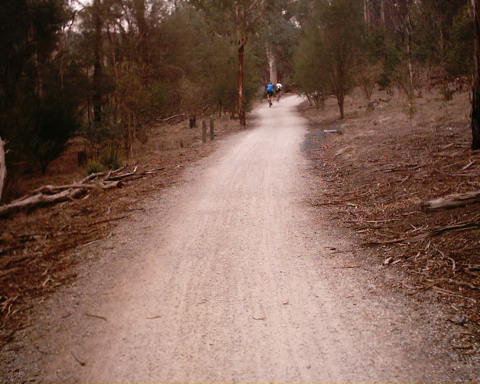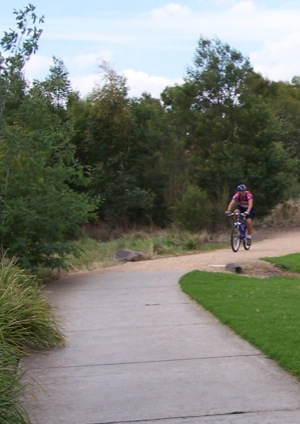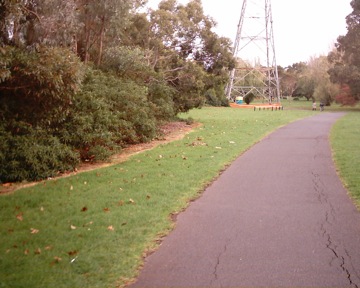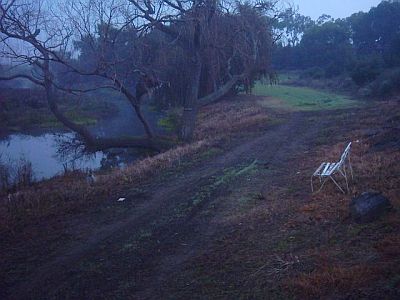Have you given much thought to the surface on your local shared path? I don't normally, but since making a crack about the variable surface on the Dandenong Creek Trail for some reason I've been giving it a bit of brain time. I haven't really unravelled anything earth-shattering, but for what it's worth here are some of the pros and cons I've listed.
Gravel

Pros:
-
generally a firm riding surface (if well laid and packed-down)
-
on high-traffic paths, constant rolling of tyres can make it smoother than lumpy asphalt
-
presumably the cheapest and easiest option to lay
-
easy to repair (dump some more gravel on top and roll it flat)
-
harder for drunken idiots to break their empty bottles on
Cons:
-
can be lumpy, bumpy, uneven, and slippery
-
if the wrong kind of gravel is used—forget it
-
usually follows the contour of the ground, which makes for badly cambered corners
-
easily damaged by water
Concrete

Pros:
-
smo-o-oth
-
for some reason, concrete paths often seem to be synonymous with "wide" (but there's no real reason why this should be so)
Cons:
-
when it cracks or bulges, you get big cracks or bulges
-
sometimes comes with a nasty drop-off at the edges (often up to several inches—more than enough to cause a nasty fall)
-
probably the hardest to repair properly (and no, dumping some hot mix over a hole doesn't qualify as a proper repair)
Asphalt

Pros:
-
can be as smooth as concrete (without the thumping over expansion joints)
-
easily patched
Cons:
-
tends to go lumpy after a few years (tree roots a specialty)
-
easily patched
Dirt

Photo credit: smc
Pros:
-
not usually the "official" path, which means it goes where people really want to go
-
often single-track
Cons:
-
mud, slush, erosion…
-
often single-track
-
a rougher route compared to other options
And what do I conclude from all of this? I don't really care how a bike path is laid, as long as it's done properly and maintained well.
Mine would probably be asphalt with concrete edges. From what I saw when they were redoing a section of the outer circle the edges themselves are around 40cm deep so you can be sure that the path is nice and stable.
Although gravel can be good, it is my least favourite as it can go bad really quickly. One time I rode down the Maribyrnong River was a week or two after a lot of rain, it ranged between jarring over large rocks to very soft drifts of sand.
Also, I can think of a narrow concrete path and that is the upper section of the Plenty River trail which is only about a metre wide.
Ashphalt is also cheaper than concrete.
However, my preferred option is concrete. I find asphalt slowly warps, leaving you with bumps and dips that just seem to kill all your forward momentum. It also seems to do this within a year. I'm betting the new tracks along Yarra Boulevard are just as crap as the old ones within a year or two, and I'll ride up and down hills and along peak hour roads rather than along the bits of Scotchman's creek between Oakleigh and Mt Waverley.
Whereas concrete often breaks in a single spot, leaving you with one bump rather than 10 small ones. It seems to last longer, with less overall wear.
Comments
I wondered whether I should mention the asphalt-with-concrete-edges as a separate entry.
I call these as "Boorondara-style" bike paths because that's the only place I've seen them for any great length (which probably just reflects my limited travels). The drawback on these is that you can still get that nasty drop-off at the edges, but where I've seen them recently installed they are generally pretty good. I think it is also a promising indication that a council laying such paths is serious about building and maintaining good paths.
It's true that one of the problems with concrete paths (especially older ones) is that they can sometimes be laid at the same width as a standard footpath on the street, which is not nearly wide enough.
I agree with eccles about the Scotchman's Creek trail—I've started avoiding that stretch too. But I don't share that prediction on the Yarra Trail—having ridden the section between St Kev's and MacRobertsons Bridge while it was being relaid, I can say that to my unqualified eye it looked very much like a road being laid: it was excavated to allow for proper foundations and several layers of bitumen were poured. This doesn't mean it won't eventually crack, but I think it will be a long time before that particular path will be described as "lumpy". (And let's not forget what it was like before!)